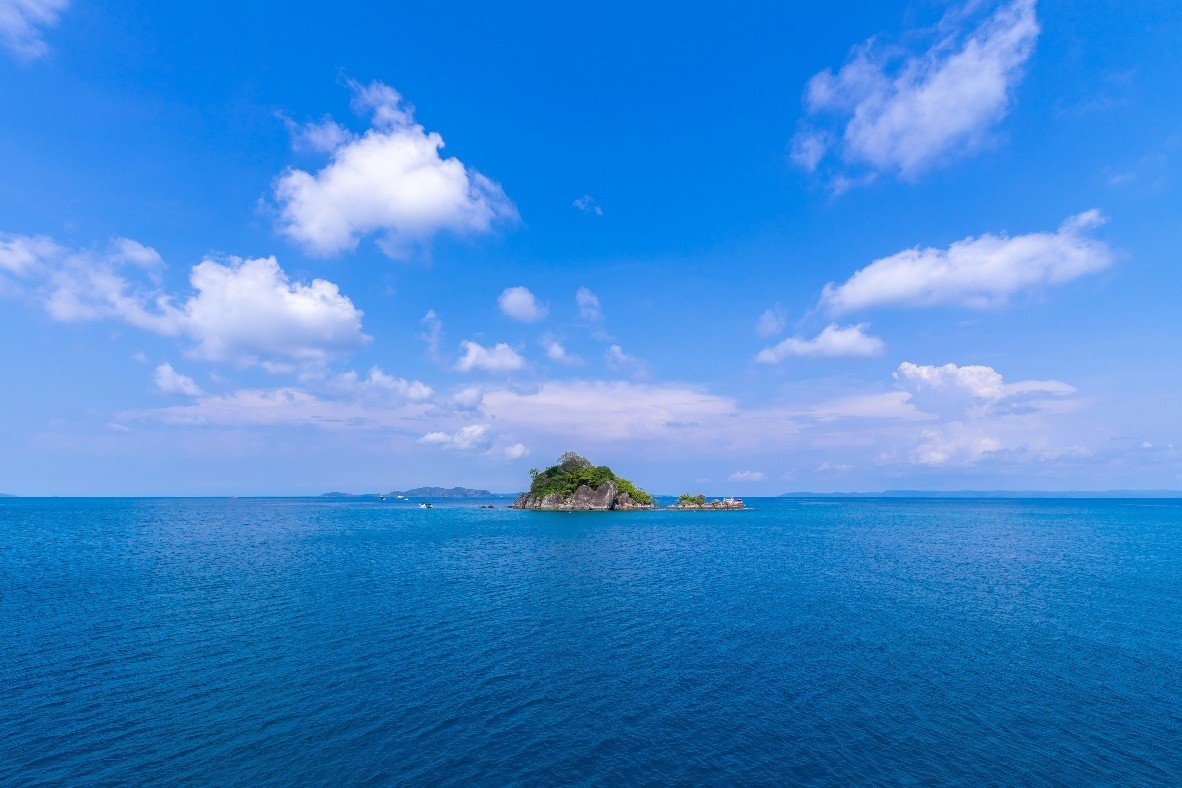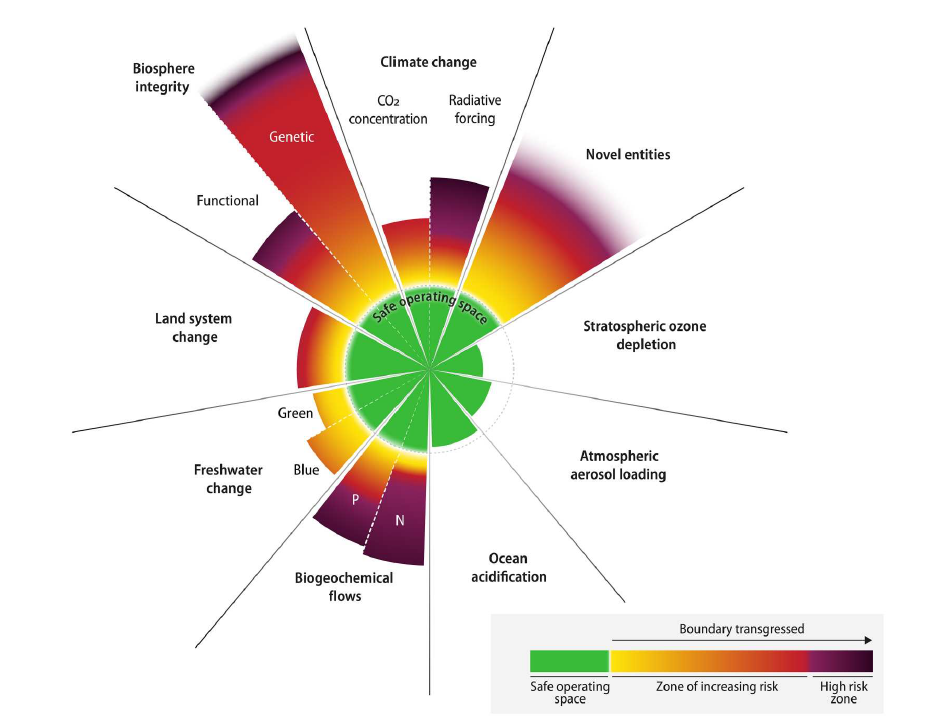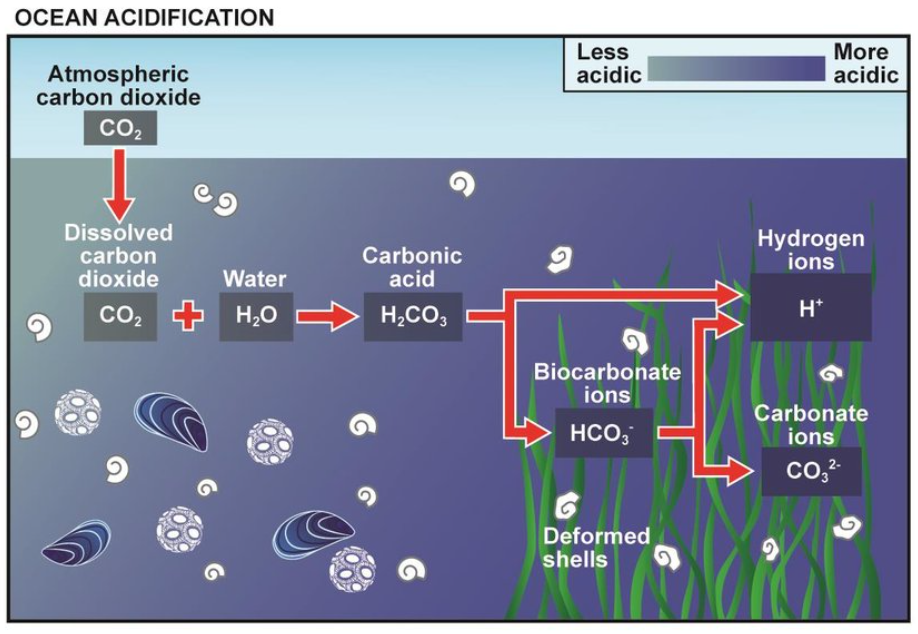
Building within Boundaries
Ocean Acidification
- Ocean acidification brings risks to marine biodiversity, food security, coastal infrastructure, and economic stability.
- Investors have a crucial role in driving corporate accountability and supporting resilient, boundary-safe development.
The Earth is a dynamic system which is made up of four interconnected spheres: the atmosphere (air), hydrosphere (water), biosphere (living things – plants and animals) and geosphere (land and rocks). The interactions between these four spheres shape the planet’s climate, ecosystems and landscapes.
To safeguard these vital Earth systems, scientist have developed the Planetary Boundaries Framework, first introduced by the Stockholm Resilience Centre. This framework outlines nine critical processes that are critical for maintaining the stability and resilience of the Earth’s interconnected systems. These boundaries define a safe operating space for humanity. Within which the Earth can continue to regulate climate, recycle nutrients, and provide life-supporting resources like air, water and food. These nine planetary boundaries are:
- Biodiversity integrity
- Climate Change
- Novel Entities (e.g. chemical pollution and plastics)
- Stratospheric Ozone Depletion
- Atmospheric Aerosol Loading
- Ocean Acidification
- Biogeochemical flows (nitrogen and phosphorus cycles)
- Freshwater use
- Land-System Change
Crossing these boundaries put the Earth into imbalance. This increases the risk of triggering large-scale, irreversible environmental changes and the breakdown of various Earth systems. Operating within the nine planetary boundaries ensures that the Earth’s four spheres can continue to interact in a balanced and life-supporting manner.
By the late 19th century, humanity had already pushed past one planetary boundary (Richardson et al., 2023). As the 20th century unfolded, more boundaries were steadily breached. Today, we’ve exceeded seven out of nine (Findlay et al., 2025; Richardson et al., 2023), leaving only atmospheric aerosol loading and stratospheric ozone depletion within safe limits. In 2024, researchers confirmed that ocean acidification had also crossed its threshold (Findlay et al., 2025).

Fig. 1: 2023 Status of Planetary Boundaries (Richardson et al., 2023)
Ocean acidification occurs due to an increase in carbon dioxide in the atmosphere. The interaction between ocean water and atmospheric carbon dioxide results in a chemical process, forming carbonic acid. The carbonic acid would then break down into bicarbonate and hydrogen ions, and the increase in hydrogen ions lowers the pH of the ocean, making it more acidic. These changes in the equilibrium between the atmospheric and oceanic systems drive ocean acidification.

Fig. 2: Schematic diagram of the process of ocean acidification (Birchenough et al., 2017)
This change brings about several issues, ranging from biodiversity degradation to resource depletion. Many underwater organisms have calcium carbonate skeletons, and corals are made of calcium carbonate. With an increase in ocean acidification, the calcification of their invertebrates would face significant challenges. Recent research showed that herbivores are disproportionately more affected by the negative impacts of ocean acidification (Hu et al., 2024). This is a great concern for the stability of the food chain, as herbivores form the basis of the food chain, and they are food sources for predators (Hu et al., 2024). The weakened calcification of these herbivores would decrease the longevity of the organisms and, in the long run, impact the food chain. Consequently, humans would be faced with challenges in food sourcing as there would be fewer marine animals available as our food sources. This would threaten the very seafood that we enjoy. Singapore’s national dish, chili crab, would also get increasingly more expensive as crabs struggles to adapt to the decrease in pH of the ocean waters.
Additionally, the problem of weakened calcification of the vertebrate affects corals heavily. Corals are not just aesthetically pleasing, but it is also crucial for coastal protection and form habitats for many other organisms. Losing the world’s coral reefs endangers not just marine species but also puts communities living along those coastlines in danger. Corals act as natural barriers protecting shorelines; without them, countries risk erosion from wave action and losing important parts of their shorelines. This is detrimental to the country’s economy and brings about increased risks from natural disasters, which can result in high financial losses. It is estimated that coastal flooding would bring about a staggering $14.2 trillion in financial damage (Kirezci et al., 2020). Losing these natural flood barriers is not just a loss to the environment but also a financial loss to us.
Back in secondary school, we had many science experiments, and one of them was submerging an egg in vinegar. The next day, you will find that the eggshell is gone. Similarly, there are always calcium-based natural structures submerged in the ocean. With the ocean becoming increasingly acidic, these structures will break down just like the eggshell in the science experiment. These structures are limestone landscapes or karst landscapes, which can be found worldwide. A karst landscape which is close to home is the iconic Ha Long Bay in Philippines. Limestone is made up of calcium carbonate, which breaks down faster in increasingly more acidic conditions. With the decrease in pH of the ocean, these limestone structures start to dissolve and disintegrate into the water at an unprecedented rate. Soon, tourists would not have the chance to sit on a cruise to view those mighty structures in the Philippines as they disappear with the waves.

Fig. 3: Ha Long Bay, Philippines (IUGS – International Commission on Geoheritage, 2024)
This problem extends far beyond just tourism and losing scenic views. The construction industry heavily depends on limestone for the development of infrastructure. Limestone is an important component of the manufacturing of cement, an important ingredient in concrete mixtures. Limestones are harvested from quarries and then processed in a blast furnace to produce the grey slurry, which we are all familiar with. Without this natural resource, we lack the capabilities to manufacture cement to build new infrastructures. In South East Asia, where most countries are still developing, the lack of cement would hinder urbanization and thereby economic prosperity within these countries. Although our skin might not feel the tingly sensation of the changes in the acidity when we go to the beach for a dip, the limestone would feel that they are losing parts of itself faster than usual. The sensation which we as indirect consumers of cement will definitely feel is the pinch in our wallets as prices go up due to the lack of raw materials.
The truth about our Earth system is that not one of these nine processes stand in silo. Each process is dependent on another, and the disequilibrium of one would create a ripple effect on the other. The very process of acidification is caused by the surplus in the atmospheric carbon budget, which also causes climatic changes. The intricacy of the Earth systems would mean that many of these processes are interdependent and important. As much as this topic might not seem like our direct concern, our environment is important to the support of economic processes, and the neglect of it might be the silent killer behind the status quo of economic growth.
After understanding the nine planetary boundaries, how can we continue to enjoy the benefits which the Earth brings to us? In July of this year, the Texas flood claimed the lives of more than 100 people and heat waves this summer has caused the death of more than a thousand individuals. Scientists also forecast that natural disasters would happen more frequently with an increase in intensity. With that, the World Bank estimated a global annual consumption loss (human and economic losses) of $520 billion due to disasters caused by natural hazards (UN Trade and Development et al., 2018). Nonetheless, all hope is not lost yet.
As the world starts to see the importance of environmental conservation, efforts for climate financing have greatly increased despite the delayed delivery of meeting the targets. As investors, we consider the influence we have over how companies contribute to a more livable world. We want companies to be aware of the financial and environmental costs and uncover the potential opportunities which will position themselves favorably. Our investment decisions favor long term commitments and actions that assure sustained returns and keep within the boundaries of our earth systems.
The Blueprint
With the ever-changing landscape around us, it can get overwhelming to stay up-to-date. The Blueprint highlights pertinent global Environmental, Social, and Governance (ESG) issues and their importance to investors and the wider community. We look forward to engaging in discussions about the interconnections between climate, nature, and social outcomes that impact our investments and our futures.
References
Birchenough, S., Williamson, P., & Turley, C. (2017). Future of the sea: ocean acidification. In https://www.gov.uk/go-science. https://assets.publishing.service.gov.uk/media/5a81e073e5274a2e87dbff33/Ocean_Acidification_final_v3.pdf
Findlay, H. S., Feely, R. A., Jiang, L., Pelletier, G., & Bednaršek, N. (2025). Ocean acidification: another planetary boundary crossed. Global Change Biology, 31(6). https://doi.org/10.1111/gcb.70238
Hu, N., Bourdeau, P. E., & Hollander, J. (2024). Responses of marine trophic levels to the combined effects of ocean acidification and warming. Nature Communications, 15(1). https://doi.org/10.1038/s41467-024-47563-3
IUGS – International Commission on Geoheritage. (2024, July 18). Ha Long Bay-Cat Ba Archipelago – IUGS. IUGS. https://iugs-geoheritage.org/geoheritage_sites/ha-long-bay-cat-ba-archipelago/
Kirezci, E., Young, I. R., Ranasinghe, R., Muis, S., Nicholls, R. J., Lincke, D., & Hinkel, J. (2020). Projections of global-scale extreme sea levels and resulting episodic coastal flooding over the 21st Century. Scientific Reports, 10(1). https://doi.org/10.1038/s41598-020-67736-6
Richardson, K., Steffen, W., Lucht, W., Bendtsen, J., Cornell, S. E., Donges, J. F., Drüke, M., Fetzer, I., Bala, G., Von Bloh, W., Feulner, G., Fiedler, S., Gerten, D., Gleeson, T., Hofmann, M., Huiskamp, W., Kummu, M., Mohan, C., Nogués-Bravo, D., . . . Rockström, J. (2023). Earth beyond six of nine planetary boundaries. Science Advances, 9(37). https://doi.org/10.1126/sciadv.adh2458
UN Trade and Development, United Nations Office for Disaster Risk Reduction, & International Trade Centre. (2018, October 18). Interactive discussion: Reducing Economic Losses Caused by Disasters. UN Trade and Development (UNCTAD). https://unctad.org/meeting/interactive-discussion-reducing-economic-losses-caused-disasters#:~:text=The%20World%20Bank%20estimates%20that,for%20a%20string%20of%20reasons.
Important Information
This material is provided by Phillip Capital Management (S) Ltd (“PCM”) for general information only and does not constitute a recommendation, an offer to sell, or a solicitation of any offer to invest in any of the exchange-traded fund (“ETF”) or the unit trust (“Products”) mentioned herein. It does not have any regard to your specific investment objectives, financial situation and any of your particular needs.
The information provided herein may be obtained or compiled from public and/or third party sources that PCM has no reason to believe are unreliable. Any opinion or view herein is an expression of belief of the individual author or the indicated source (as applicable) only. PCM makes no representation or warranty that such information is accurate, complete, verified or should be relied upon as such. The information does not constitute, and should not be used as a substitute for tax, legal or investment advice.
The information herein are not for any person in any jurisdiction or country where such distribution or availability for use would contravene any applicable law or regulation or would subject PCM to any registration or licensing requirement in such jurisdiction or country. The Products is not offered to U.S. Persons. PhillipCapital Group of Companies, including PCM, their affiliates and/or their officers, directors and/or employees may own or have positions in the Products. This advertisement has not been reviewed by the Monetary Authority of Singapore.
